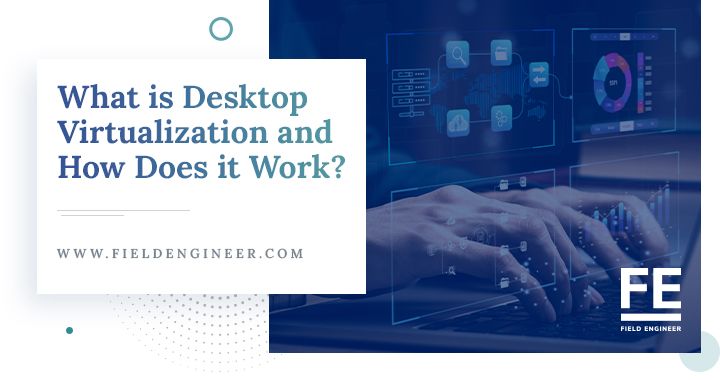What is Desktop Virtualization and How Does it Work?
Tired of managing multiple desktops for your business? Try desktop virtualization! It offers flexible, secure access from anywhere, on any device, and keeps data safe. In this article, learn more benefits, types, and how to choose the right solution.

Are you tired of dealing with the hassle of maintaining multiple desktop computers for your business? Do you want the flexibility to work from anywhere without compromising security? Desktop virtualization may be the solution you need.
With the increasing demand for remote work and the need for secure data storage, desktop virtualization has become a popular option for businesses of all sizes. It allows users to access their desktop environment from any device, anywhere in the world, while maintaining their data's security and integrity.
This article explores desktop virtualization, how it works, and its benefits for businesses. We'll also discuss the different types of desktop virtualization available and what factors to consider when choosing a solution. If you're considering desktop virtualization for your business, this article will provide the information you need to make an informed decision.
What is Desktop Virtualization?
Desktop virtualization is a technology that allows users to access their desktop environment and applications from anywhere with an available internet connection. This means that, instead of sitting at one physical device to access files or applications, users can log into any compatible computing device and gain access to the same desktop set-up. In this way, individuals do not need to install separate software versions on multiple machines – they simply need one virtualized copy that can be accessed from any location.
Using virtualization also prevents data loss due to hardware failure; as long as all applications and files are stored in the cloud, no physical device can break down and cause the system’s entire contents to be lost. Additionally, this technology eliminates many logistical issues related to maintaining different systems at various locations by having a single source of software updates for all computers. As such, desktop virtualization encourages user collaboration across locations without costly delays or IT support requests commonly associated with traditional computer networks.

How Does Desktop Virtualization Work?
Desktop virtualization is a process in which a physical computer system is turned into multiple virtual instances of itself. It takes advantage of hardware virtualization, which allows the host server’s processing power and memory to be shared across multiple virtual desktops. To gain access to the virtual desktop environment, users need to download and install a remote desktop protocol (RDP) client onto their local machines. This client creates an interface between the user device and the connection broker.
The connection broker acts like an administrator that acts according to policies in place, guiding how users are matched with their specific virtual desktop. Virtual desktops are typically non-persistent, meaning they reset every time they are used. When a new user connects through the RDP client or established connection via the connection broker, a random instance from the desktop pool is given to establish all users with a more ‘universal’ experience while maintaining overall efficiency for each connecting user.
Types of Desktop Virtualization
When considering a desktop virtualization solution, businesses have three primary options to choose from: Virtual desktop infrastructure (VDI), Desktop-as-a-Service (DaaS), and Remote desktop services (RDS)
Virtual desktop infrastructure (VDI)
Virtual desktop infrastructure (VDI) is a modern IT deployment model that allows businesses to flexibly assign specific virtual machines with their dedicated operating systems and applications to each user. VDI has an energy-efficient pricing model, requiring significantly less hardware investment and eliminating physical maintenance costs associated with hardware servers.
This technology increases reliability and resiliency, making it particularly popular for security-sensitive organizations. To use the VDI model, either company can invest in their own server equipment and operate on-site or use the services of a service provider who will host all the virtual machines in their data centers. Depending on your needs, this technology enables you to assign individual users or user groups with predetermined apps, services and tools available on the desktops they access remotely from any device. Once the secure connection is established between the server and the user's device, a desktop image is transferred in real-time over the network allowing the user complete control of their virtual machine.
Desktop-as-a-Service (DaaS)
Desktop as a Service (DaaS) is an increasingly popular cloud-based deployment model that allows companies to rent virtual machines from a provider. This model offers less customization than physical infrastructure and often comes with a standard virtual desktop shared across employees with limited software installations and no user storage settings saved. If individual employees need different toolsets, additional subscription plans must be purchased, resulting in additional costs that may defeat the argument of DaaS being the most affordable option.
However, this cloud-based technology still has its advantages. Setting up and running a DaaS deployment is typically quicker than other models, making it ideal for companies that need to scale their IT infrastructure rapidly. Moreover, since there is no commitment to long-term contracts or expensive configuration fees, users can pay only for what they need without wasting money on unnecessary features or services. As such, DaaS can be especially beneficial for those looking for a cost-effective solution with quick implementation times.
Remote desktop services (RDS)
The Remote Desktop Services (RDS) deployment model, also known as Microsoft Terminal Server, is similar to VDI in concept but is exclusively powered by Microsoft’s Windows Server Operating System. This uses a remote protocol known as Microsoft Remote Desktop Protocol (RDP) which allows access to only Windows server applications for users connected with their virtual desktops. Allowing more than two users to remotely requires purchasing additional licenses.
What makes this type of deployment viable is the extra safety measures taken to protect any data stored on its servers. Using encryption and advanced authentication protocols, Microsoft has ensured that companies using RDS can feel assured their valuable information will remain secure. Another advantage to using RDS since 2018 is that it has been cloud-based and even includes a web client for easier access across different types of devices. This makes it an excellent solution for businesses looking for maximum convenience and minimum hassle when using remote desktops.
Benefits of Desktop Virtualization
Desktop virtualization can provide numerous benefits to both individuals and businesses. It may be implemented in several ways, allowing users to access their desktop environment, applications, and data from anywhere on any device, creating greater efficiency and flexibility. Additionally, it enables a greatly increased level of server utilization and therefore helps maximize the return on technology investments.
One of the main benefits is security. Organizations can reduce the risk of a malicious attack or data leak by separating users’ desktops from physical hardware (servers, PCs, etc.) by directly housing instances of desktops within the data center.
Furthermore, desktop virtualization often simplifies routine management tasks such as software updates or anti-virus patching due to centralizing them in a single location instead of needing manual updates across each individual device. Finally, by taking advantage of dedicated network resources through a data center infrastructure integration system (DCIIS) instead of sharing resources over the local area network (LAN), companies may experience first-class performance when referencing applications stored in remote data centers regardless of geographic location or internet connection speed.
How to Choose the Right Desktop Virtualization Type
Desktop virtualization is a great way to utilize computing resources more efficiently, increase business agility, and reduce costs. With a range of solutions available, it can take time to decide which one is right for you. Before choosing the right virtualization solution, there are several factors to consider:
Firstly, you should assess the costs associated with setting up and deploying virtual desktops. The hardware needed to support virtual desktops and the number of users who will access them need to be considered when analyzing cost. Additionally, you should evaluate if your organization has the resources and expertise to utilize the virtualized platform and correctly manage its implementation.
Secondly, you must take into account the level of control each provider offers over their infrastructure and how much elasticity or scalability they offer from slow periods of activity throughout the year. If your organization wishes for an environment that gives it maximum capacity and business agility flexibility, then this is a crucial area of focus. Security features available with these providers also need to be reviewed, as this will have a major bearing on the user experience being offered. Ultimately, having all this information at hand enables businesses to make an informed decision when selecting their desktop virtualization solution to ensure they get the best value for their money.
Finally, the user experience should also be considered when choosing a desktop virtualization solution. Features such as access to applications and files from multiple devices, collaborative tools, enhanced user interfaces, and data security are all important considerations. These features can greatly improve the user experience in terms of efficiency and productivity. An effective endpoint management system is also essential for securely deploying and managing virtual desktops across multiple devices.
Final thoughts
In conclusion, desktop virtualization is a great way for organizations to modernize and gain freedom with their business as it provides scalability, versatility, and flexibility to the table, allowing them to have greater control and management of their processes. In addition, organizations will be able to ensure their user’s data is secure since all user data and programs remain in the desktop virtualization server instead of being stored on individual client devices.
With the increased market competition, many VMI solutions are now available which can cater to businesses of any size. The overall cost savings from implementing this technology prove that it’s one of the soundest investments businesses can make today. Therefore, it continues to be a popular choice among many companies looking for an efficient solution to handle their operations in the modernized age.



